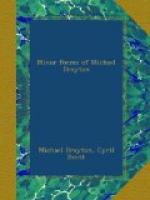In 1604 he published the Owle, a mild satire, under the form of a moral fable of government, reminding the reader a little of the Parlement of Foules. The Man in the Moone (1606) is partly a recension of Endimion and Phoebe, but is a heterogeneous mass of weakly satire, of no particular merit. The Moon-Calfe (1627) is Drayton’s most savage and misanthropic excursion into the region of Satire; in which, though occasionally nobly ironic, he is more usually coarse and blustering, in the style of Marston.[22] In 1605 Drayton brought out his first ‘collected poems’, from which the Eclogues and the Owle are omitted; and in 1606 he published his Poemes Lyrick and Pastorall, Odes, Eglogs, The Man in the Moone. Of these the Eglogs are a recension of the Shepherd’s Garland of 1593: we have already spoken of The Man in the Moone. The Odes are by far the most important and striking feature of the book. In the preface, Drayton professes to be following Pindar, Anacreon, and Horace, though, as he modestly implies, at a great distance. Under the title of Odes he includes a variety of subjects, and a variety of metres; ranging from an Ode to his Harp or to his Criticks, to a Ballad of Agincourt, or a poem on the Rose compared with his Mistress. In the edition of 1619 appeared several more Odes, including some of the best; while many of the others underwent careful revision, notably the Ballad. ’Sing wee the Rose,’ perhaps because of its unintelligibility, and the Ode to his friend John Savage, perhaps because too closely imitated from Horace, were omitted. Drayton was not the first to use the term Ode for a lyrical poem, in English: Soothern in 1584, and Daniel in 1592 had preceded him; but he was the first to give the name popularity in England, and to lift the kind as Ronsard had lifted it in France; and till the time of Cowper no other English poet showed mastery of the short, staccato measure of the Anacreontic as distinct from the Pindaric Ode. In the Odes Drayton shows to the fullest extent his metrical versatility: he touches the Skeltonic metre, the long ten-syllabled line of the Sacrifice to Apollo; and ascends from the smooth and melodious rhythms of the New Year through the inspiring harp-tones of the Virginian Voyage to the clangour and swing of the Ballad of Agincourt. His grammar is possibly more distorted here than anywhere, but, as Mr. Elton says, ’these are the obstacles of any poet who uses measures of four or six syllables.’ His tone throughout is rather that of the harp, as played, perhaps, in Polesworth Hall, than that of any other instrument; but in 1619 Drayton has taken to him the lute of Carew and his compeers. In 1619 the style is lighter, the fancy gayer, more exquisite, more recondite. Most of his few metaphysical conceits are to be found in these later Odes, as in the Heart,




